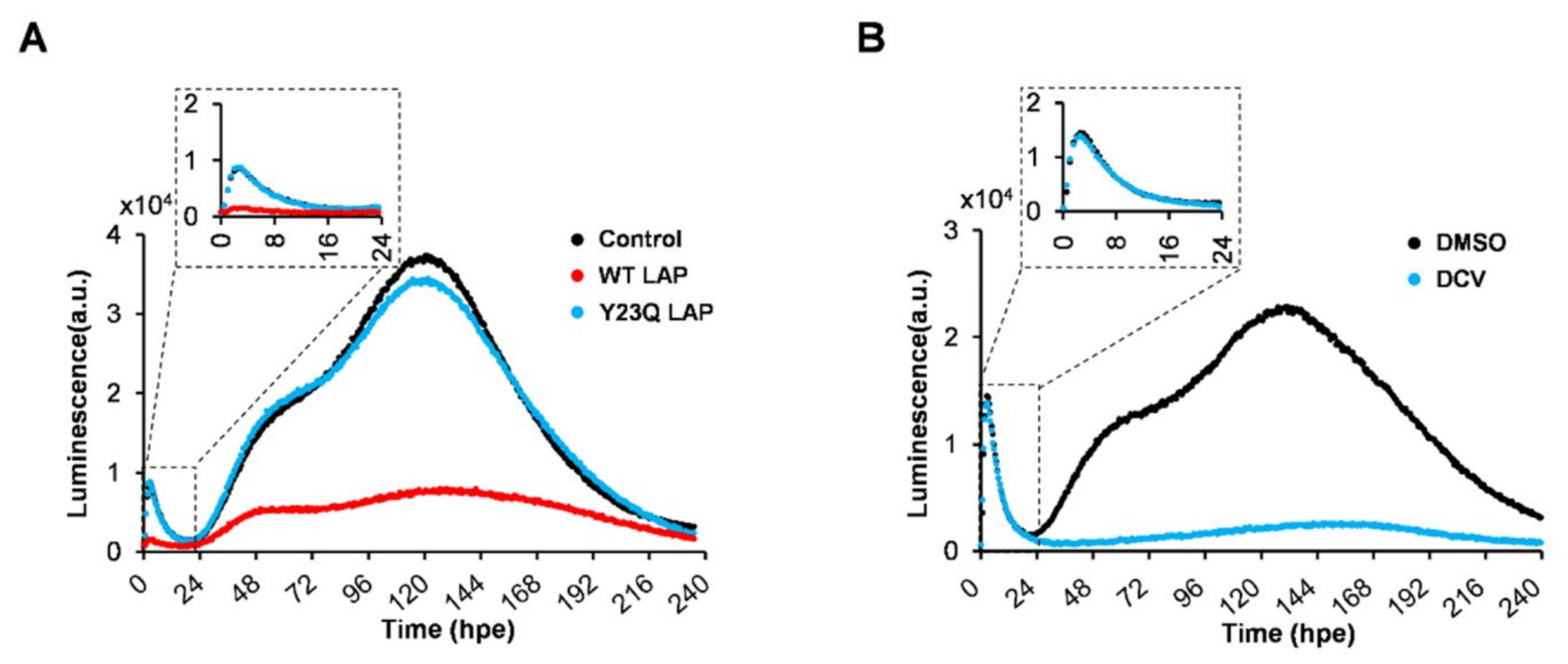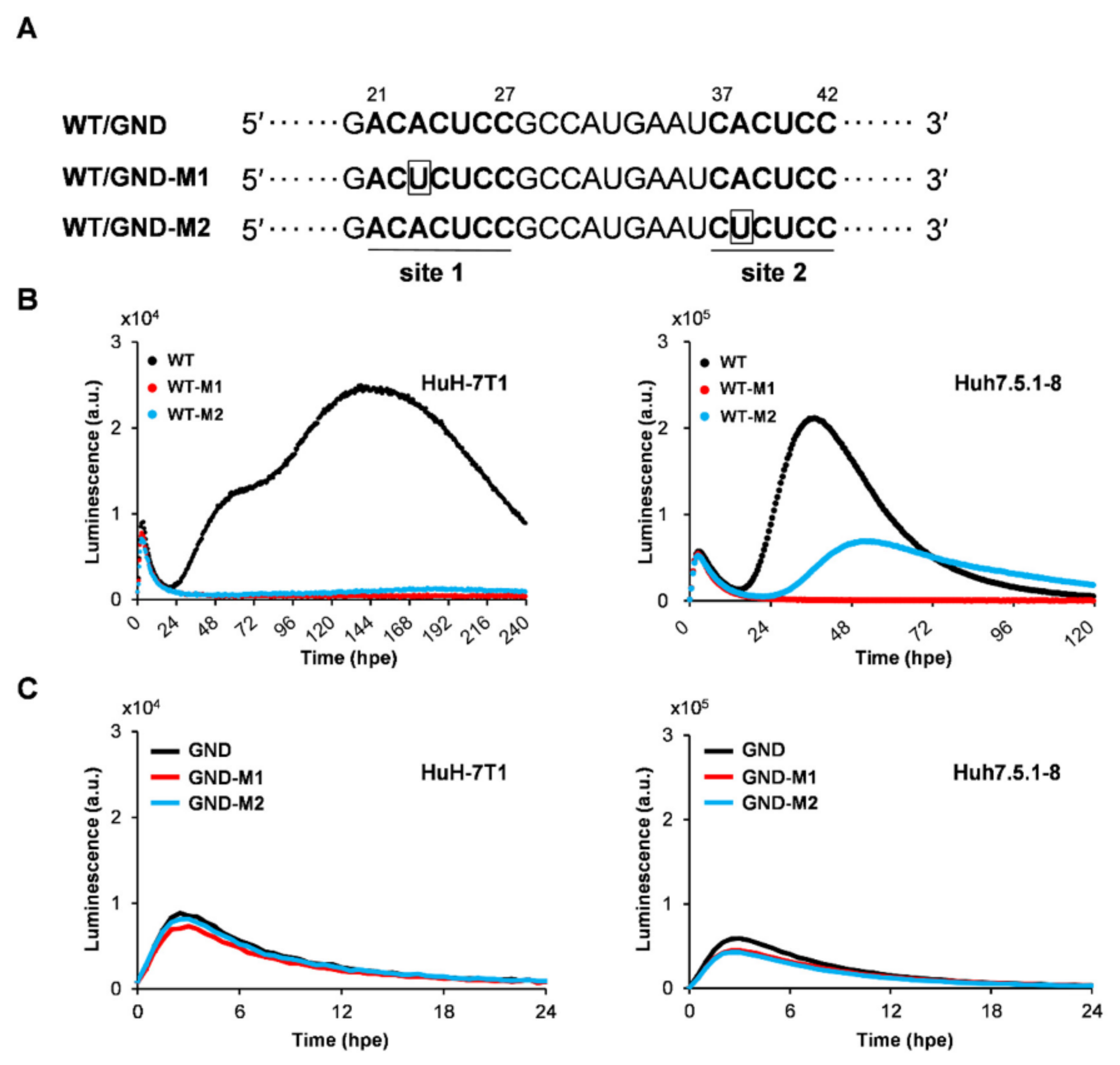Development and Use of a Kinetical and Real-Time Monitoring System to Analyze the Replication of Hepatitis C Virus
Abstract
:1. Introduction
2. Results
Development of a Real-Time, Kinetic Monitoring System of HCV Replicon Activity
3. Discussion
4. Materials and Methods
4.1. Cell Culture
4.2. Reagents
4.3. Plasmids
4.4. RNA Synthesis, Electroporation, and Transfection
4.5. Real-Time Detection of Bioluminescence in Cell Cultures
4.6. Immunoblotting
4.7. Cell Growth Measurement
4.8. RNA Extraction and RT-Quantitative PCR (qPCR)
4.9. Flow Cytometry and Cell Viability Assay
4.10. Endpoint IRES Assay
4.11. Ultrastructural Analysis
Supplementary Materials
Author Contributions
Funding
Institutional Review Board Statement
Informed Consent Statement
Data Availability Statement
Acknowledgments
Conflicts of Interest
References
- McGlynn, K.A.; Petrick, J.L.; El-Serag, H.B. Epidemiology of Hepatocellular Carcinoma. Hepatology 2021, 73 (Suppl. 1), 4–13. [Google Scholar] [CrossRef] [PubMed]
- D’Souza, S.; Lau, K.C.; Coffin, C.S.; Patel, T.R. Molecular mechanisms of viral hepatitis induced hepatocellular carcinoma. World J. Gastroenterol. 2020, 26, 5759–5783. [Google Scholar] [CrossRef] [PubMed]
- Steinmann, E.; Pietschmann, T. Cell culture systems for hepatitis C virus. Curr. Top. Microbiol. Immunol. 2013, 369, 17–48. [Google Scholar] [CrossRef] [PubMed]
- Suzuki, R.; Saito, K.; Kato, T.; Shirakura, M.; Akazawa, D.; Ishii, K.; Aizaki, H.; Kanegae, Y.; Matsuura, Y.; Saito, I.; et al. Trans-complemented hepatitis C virus particles as a versatile tool for study of virus assembly and infection. Virology 2012, 432, 29–38. [Google Scholar] [CrossRef] [Green Version]
- Izumi, R.E.; Das, S.; Barat, B.; Raychaudhuri, S.; Dasgupta, A. A peptide from autoantigen La blocks poliovirus and hepatitis C virus cap-independent translation and reveals a single tyrosine critical for La RNA binding and translation stimulation. J. Virol. 2004, 78, 3763–3776. [Google Scholar] [CrossRef] [Green Version]
- Furuya, T.; Takehara, I.; Shimura, A.; Kishimoto, H.; Yasujima, T.; Ohta, K.; Shirasaka, Y.; Yuasa, H.; Inoue, K. Organic anion transporter 1 (OAT1/SLC22A6) enhances bioluminescence based on d-luciferin-luciferase reaction in living cells by facilitating the intracellular accumulation of d-luciferin. Biochem. Biophys. Res. Commun. 2018, 495, 2152–2157. [Google Scholar] [CrossRef]
- Shirasago, Y.; Sekizuka, T.; Saito, K.; Suzuki, T.; Wakita, T.; Hanada, K.; Kuroda, M.; Abe, R.; Fukasawa, M. Isolation and characterization of an Huh.7.5.1-derived cell clone highly permissive to hepatitis C virus. Jpn. J. Infect. Dis. 2015, 68, 81–88. [Google Scholar] [CrossRef] [Green Version]
- Murayama, A.; Sugiyama, N.; Yoshimura, S.; Ishihara-Sugano, M.; Masaki, T.; Kim, S.; Wakita, T.; Mishiro, S.; Kato, T. A subclone of HuH-7 with enhanced intracellular hepatitis C virus production and evasion of virus related-cell cycle arrest. PLoS ONE 2012, 7, e52697. [Google Scholar] [CrossRef]
- Lohmann, V.; Korner, F.; Koch, J.; Herian, U.; Theilmann, L.; Bartenschlager, R. Replication of subgenomic hepatitis C virus RNAs in a hepatoma cell line. Science 1999, 285, 110–113. [Google Scholar] [CrossRef] [Green Version]
- Wakita, T.; Pietschmann, T.; Kato, T.; Date, T.; Miyamoto, M.; Zhao, Z.; Murthy, K.; Habermann, A.; Krausslich, H.G.; Mizokami, M.; et al. Production of infectious hepatitis C virus in tissue culture from a cloned viral genome. Nat. Med. 2005, 11, 791–796. [Google Scholar] [CrossRef] [Green Version]
- Kim, S.; Date, T.; Yokokawa, H.; Kono, T.; Aizaki, H.; Maurel, P.; Gondeau, C.; Wakita, T. Development of hepatitis C virus genotype 3a cell culture system. Hepatology 2014, 60, 1838–1850. [Google Scholar] [CrossRef] [Green Version]
- Machlin, E.S.; Sarnow, P.; Sagan, S.M. Masking the 5’ terminal nucleotides of the hepatitis C virus genome by an unconventional microRNA-target RNA complex. Proc. Natl. Acad. Sci. USA 2011, 108, 3193–3198. [Google Scholar] [CrossRef] [Green Version]
- Zou, G.; Xu, H.Y.; Qing, M.; Wang, Q.Y.; Shi, P.Y. Development and characterization of a stable luciferase dengue virus for high-throughput screening. Antivir. Res. 2011, 91, 11–19. [Google Scholar] [CrossRef]
- Puig-Basagoiti, F.; Deas, T.S.; Ren, P.; Tilgner, M.; Ferguson, D.M.; Shi, P.Y. High-throughput assays using a luciferase-expressing replicon, virus-like particles, and full-length virus for West Nile virus drug discovery. Antimicrob. Agents Chemother. 2005, 49, 4980–4988. [Google Scholar] [CrossRef] [Green Version]
- Arenhart, S.; Flores, E.F.; Weiblen, R.; Gil, L.H. Insertion and stable expression of Gaussia luciferase gene by the genome of bovine viral diarrhea virus. Res. Vet. Sci. 2014, 97, 439–448. [Google Scholar] [CrossRef]
- Ito, M.; Sun, S.; Fukuhara, T.; Suzuki, R.; Tamai, M.; Yamauchi, T.; Nakashima, K.; Tagawa, Y.I.; Okazaki, S.; Matsuura, Y.; et al. Development of hepatoma-derived, bidirectional oval-like cells as a model to study host interactions with hepatitis C virus during differentiation. Oncotarget 2017, 8, 53899–53915. [Google Scholar] [CrossRef] [Green Version]
- Roder, A.E.; Vazquez, C.; Horner, S.M. The acidic domain of the hepatitis C virus NS4A protein is required for viral assembly and envelopment through interactions with the viral E1 glycoprotein. PLoS Pathog. 2019, 15, e1007163. [Google Scholar] [CrossRef] [Green Version]
- Masaki, T.; Suzuki, R.; Murakami, K.; Aizaki, H.; Ishii, K.; Murayama, A.; Date, T.; Matsuura, Y.; Miyamura, T.; Wakita, T.; et al. Interaction of hepatitis C virus nonstructural protein 5A with core protein is critical for the production of infectious virus particles. J. Virol. 2008, 82, 7964–7976. [Google Scholar] [CrossRef] [Green Version]
- Kato, T.; Date, T.; Miyamoto, M.; Sugiyama, M.; Tanaka, Y.; Orito, E.; Ohno, T.; Sugihara, K.; Hasegawa, I.; Fujiwara, K.; et al. Detection of anti-hepatitis C virus effects of interferon and ribavirin by a sensitive replicon system. J. Clin. Microbiol. 2005, 43, 5679–5684. [Google Scholar] [CrossRef] [Green Version]
- Shimoike, T.; Koyama, C.; Murakami, K.; Suzuki, R.; Matsuura, Y.; Miyamura, T.; Suzuki, T. Down-regulation of the internal ribosome entry site (IRES)-mediated translation of the hepatitis C virus: Critical role of binding of the stem-loop IIId domain of IRES and the viral core protein. Virology 2006, 345, 434–445. [Google Scholar] [CrossRef] [Green Version]
- Teufel, A.I.; Liu, W.; Draghi, J.A.; Cameron, C.E.; Wilke, C.O. Modeling poliovirus replication dynamics from live time-lapse single-cell imaging data. Sci. Rep. 2021, 11, 9622. [Google Scholar] [CrossRef]





| Cell Line | Transient Translation | Replication | ||||
|---|---|---|---|---|---|---|
| Ri(T) a | Ss(T) b | Ri(R) c | Ss(R) d | Highest Activity e | ||
| (a.u./h) | (Area) | (a.u./h) | (Area) | Time (hpe) | Lum (a.u.) | |
| HuH-7T1 | 10,227 | 193,944 | 3556 | 11,451,313 | 51.5 | 151,541 |
| Huh7.5.1-8 | 18,236 | 358,071 | 10,620 | 10,725,355 | 33.5 | 289,386 |
| HuH-7-Scr | 18,391 | 336,048 | 2728 | 6,683,591 | 46.5 | 110,041 |
| HuH-7-JCRB | 6822 | 106,151 | 559 | 1,948,137 | 52.5 | 27,892 |
| HCV Genotype | Transient Translation | Replication | |||
|---|---|---|---|---|---|
| Ri(T) a | Lum b | Ri(R) c | Lum e | Time d | |
| (a.u./h) | (a.u.) | (a.u./h) | (a.u.) | (hpe) | |
| 1b | 122,959 | 412,961 | 176 | 23,399 | 70.5 |
| 2a | 45,245 | 264,026 | 62,591 | 748,140 | 33.5 |
| 3a | 7005 | 20,345 | 3 | 1028 | 99.5 |
| Cell Line | Replicon a | Transient Translation | Replication | ||||
|---|---|---|---|---|---|---|---|
| Ri(T) b | Ss(T) c | Lum d | Ri(R) e | Ss(R) f | Lum g | ||
| (a.u./h) | (area) | (a.u.) | (a.u./h) | (area) | (a.u.) | ||
| HuH-7T1 | WT | 3447 | 77,647 | 9031 | 376 | 3,615,588 | 12,527 |
| WT-M1 | 2974 | 65,383 | 7802 | <1 | 105,912 | 493 | |
| WT-M2 | 2712 | 61,398 | 7090 | 4 | 198,529 | 1346 | |
| Huh7.5.1-8 | WT | 23,439 | 454,583 | 57,147 | 10,798 | 7,997,501 | 211,445 |
| WT-M1 | 22,291 | 377,372 | 54,286 | <1 | 111,366 | 1138 | |
| WT-M2 | 21,357 | 395,020 | 52,081 | 2717 | 3,939,265 | 69,136 | |
Publisher’s Note: MDPI stays neutral with regard to jurisdictional claims in published maps and institutional affiliations. |
© 2022 by the authors. Licensee MDPI, Basel, Switzerland. This article is an open access article distributed under the terms and conditions of the Creative Commons Attribution (CC BY) license (https://creativecommons.org/licenses/by/4.0/).
Share and Cite
Li, X.; Ito, M.; Aoyagi, H.; Murayama, A.; Aizaki, H.; Fukasawa, M.; Kato, T.; Wakita, T.; Suzuki, T. Development and Use of a Kinetical and Real-Time Monitoring System to Analyze the Replication of Hepatitis C Virus. Int. J. Mol. Sci. 2022, 23, 8711. https://doi.org/10.3390/ijms23158711
Li X, Ito M, Aoyagi H, Murayama A, Aizaki H, Fukasawa M, Kato T, Wakita T, Suzuki T. Development and Use of a Kinetical and Real-Time Monitoring System to Analyze the Replication of Hepatitis C Virus. International Journal of Molecular Sciences. 2022; 23(15):8711. https://doi.org/10.3390/ijms23158711
Chicago/Turabian StyleLi, Xiaoyu, Masahiko Ito, Haruyo Aoyagi, Asako Murayama, Hideki Aizaki, Masayoshi Fukasawa, Takanobu Kato, Takaji Wakita, and Tetsuro Suzuki. 2022. "Development and Use of a Kinetical and Real-Time Monitoring System to Analyze the Replication of Hepatitis C Virus" International Journal of Molecular Sciences 23, no. 15: 8711. https://doi.org/10.3390/ijms23158711
APA StyleLi, X., Ito, M., Aoyagi, H., Murayama, A., Aizaki, H., Fukasawa, M., Kato, T., Wakita, T., & Suzuki, T. (2022). Development and Use of a Kinetical and Real-Time Monitoring System to Analyze the Replication of Hepatitis C Virus. International Journal of Molecular Sciences, 23(15), 8711. https://doi.org/10.3390/ijms23158711






